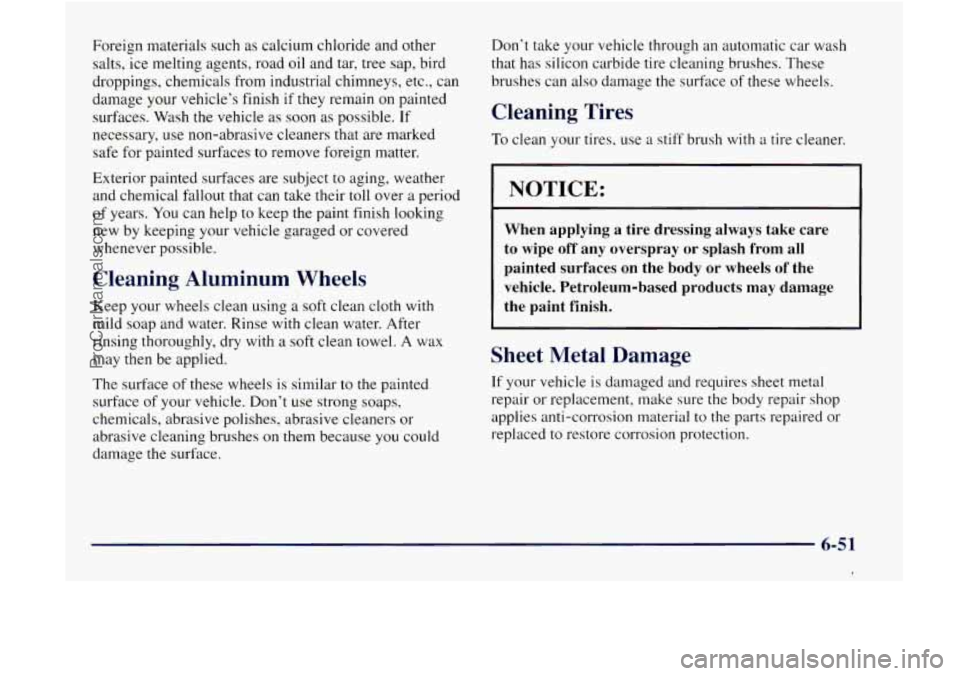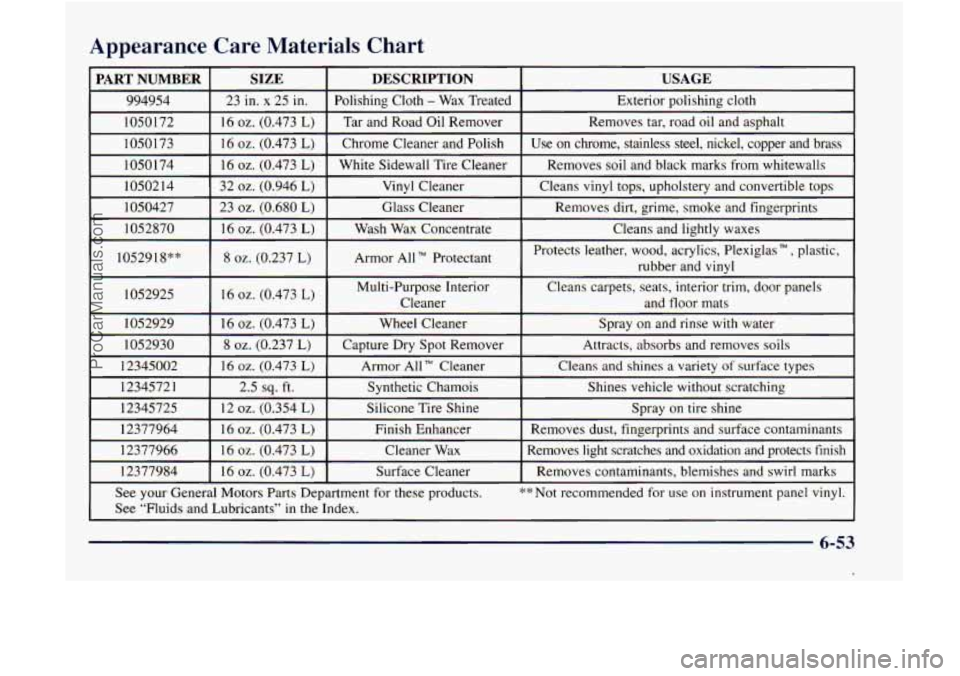1998 GMC ENVOY wheel
[x] Cancel search: wheelPage 288 of 386

I Uniform Tire Quality Grading
Mixing tires could cause you to lose control while
driving.
If you mix tires of different sizes or types
(radial and bias-belted tires), the vehicle may not
handle properly, and you could have a crash.
Using tires of different sizes may also cause
damage to your vehicle. Be sure to use the same
size and type tires on all wheels.
If you use bias-ply tires on your vehicle, the
wheel rim flanges could develop cracks after
many miles of driving.
A tire and/or wheel could
fail suddenly, causing a crash. Use only radial-ply
tires with the wheels on your vehicle.
The following information relates to the system
developed by the United States National Highway
Traffic Safety Administration, which grades tires by
treadwear, traction and temperature performance.
(This applies only to vehicles sold in the United States.)
The grades are molded on the sidewalls of most
passenger car tires. The Uniform Tire Quality Grading
system does not apply to deep tread, winter-type snow
tires, space-saver or temporary
use spare tires, tires with
nominal rim diameters
of 10 to 12 inches (25 to 30 cm),
or to some limited-production tires.
While the tires available on General Motors passenger
cars and light trucks may vary with respect to these
grades, they must also conform to Federal safety
requirements and additional General Motors Tire
Performance Criteria (TPC) standards.
6-41
ProCarManuals.com
Page 289 of 386

Treadwear Temperature -- A, B, C
The
treadwear grade is a comparative rating based on
the wear rate of the tire when tested under controlled
conditions
on a specified government test course. For
example,
a tire graded 150 would wear one and a half
(1 1/2) times as well on the government course as a tire
graded
100. The relative performance of tires depends
upon the actual conditions
of their use, however, and
may depart significantly from the norm due to variations
in driving habits, service practices and differences in
road characteristics and climate.
Traction -- A, B, C
The traction grades, from highest to lowest, are A, B,
and C, and they represent the tire’s ability to stop on
wet pavement
as measured under controlled conditions
on specified government test surfaces
of asphalt and
concrete.
A tire marked C may have poor
traction performance.
Warning: The traction grade assigned to this tire is based
on braking (straight ahead) traction tests and does not
include cornering (turning) traction. The
temperature grades are
A (the highest), B, and C,
representing the tire’s resistance to the generation of
heat and its ability to dissipate heat when tested under
controlled conditions on
a specified indoor laboratory
test wheel. Sustained high temperature can cause the
material of the tire to degenerate and reduce tire life,
and excessive temperature can lead to sudden
tire
failure. The grade C corresponds to a level of
performance which all passenger car tires must meet
under the Federal Motor Vehicle Safety Standard
No. 109. Grades B and A represent higher levels of
performance on the laboratory test wheel than the
minimum required by law.
Warning: The temperature grade for this tire is
established for a tire that is properly inflated and not
overloaded. Excessive speed, underinflation, or
excessive loading, either separately or in combination,
can cause heat buildup and possible tire failure.
6-42
ProCarManuals.com
Page 290 of 386

Wheel Alignment and Tire Balance
The wheels on your vehicle were aligned and balanced
carefully at the factory to give
you the longest tire life
and best overall performance.
Scheduled wheel alignment and wheel balancing are
not needed. However, if you notice unusual tire wear
or your vehicle pulling one way or the other, the
alignment may need to be reset. If you notice your
vehicle vibrating when driving on a smooth road,
your wheels may need to be rebalanced.
Wheel Replacement
Each new wheel should have the same load-carrying
capacity, diameter, width, offset and be mounted the
same way as the one it replaces.
If you need to replace any of your wheels, wheel
bolts or wheel nuts, replace them only with new
GM
original equipment parts. This way, you will be sure to
have the right wheel, wheel bolts and wheel nuts for
your
GMC model.
Replace any wheel that is bent, cracked, or badly rusted
Or wheel nuts on Your vehicle can be dangerous- or corroded. If wheel nuts keep coming loose, the wheel,
Using the wrong replacement wheels, wheel bolts
It could affect the braking and handling of your
wheel bolts and wheel nuts should be replaced. If the
wheel leaks air, replace
it (except some aluminum
wheels, which can sometimes be repaired). See your
dealer if any
of these conditions exist.
Your dealer will know the kind
of wheel you need.
vehicle, make your tires lose air and make you
lose control. You could have a collision in which
you or others could be injured. Always use the
correct wheel, wheel bolts and wheel nuts
for replacement.
6-43
ProCarManuals.com
Page 291 of 386

NOTICE:
The wrong wheel can also cause problems with
bearing life, brake cooling, speedometer or
odometer calibration, headlamp aim, bumper
height, vehicle ground clearance and tire
clearance to the body and chassis.
See “Changing a Flat Tire” in the Index for
more information.
Used Replacement Wheels
I
Putting a used wheel on your vehicle is
dangerous. You can’t know how it’s been used or
how far it’s been driven. It could fail suddenly
and cause an accident.
If you have to replace a
wheel, use a new GM original equipment wheel.
Tire Chains
NOTICE:
Don’t use tire chains. They can damage your
vehicle because there’s not enough clearance.
Use another type of traction device only if its
manufacturer recommends it for use on your
vehicle and tire size combination and road
conditions. Follow that manufacturer’s
instructions.
To help avoid damage to your
vehicle, drive slowly, readjust
or remove the
device
if it’s contacting your vehicle, and don’t
spin your wheels.
If you do find traction devices that will fit, install
them on the rear tires.
6-44
ProCarManuals.com
Page 298 of 386

Foreign materials such as calcium chloride and other
salts, ice melting agents, road oil and tar, tree sap, bird
droppings, chemicals from industrial chimneys, etc., can
damage your vehicle’s finish if they remain on painted
surfaces. Wash the vehicle
as soon as possible. If
necessary, use non-abrasive cleaners that are marked
safe for painted surfaces to remove foreign matter.
Exterior painted surfaces are subject to aging, weather
and chemical fallout that can take their toll over
a period
of years. You can help to keep the paint finish looking
new by keeping your vehicle garaged or covered
whenever possible.
Cleaning Aluminum Wheels
Keep your wheels clean using a soft clean cloth with
mild soap and water. Rinse with clean water. After
rinsing thoroughly, dry with a soft clean towel. A wax
may then be applied.
The surface
of these wheels is similar to the painted
surface of your vehicle. Don’t use strong soaps,
chemicals, abrasive polishes, abrasive cleaners or
abrasive cleaning brushes on them because you could
damage the surface. Don‘t take your vehicle through
an automatic car wash
that has silicon carbide tire cleaning brushes. These
brushes can
also damage the surface of these wheels.
Cleaning Tires
To clean your tires, use a stiff brush with a tire cleaner.
NOTICE:
When applying a tire dressing always take care
to wipe off any overspray or splash from all
painted surfaces on the body
or wheels of the
vehicle. Petroleum-based products may damage
the paint finish.
Sheet Metal Damage
If your vehicle is damaged and requires sheet metal
repair or replacement, make sure the body repair shop
applies anti-corrosion material
to the parts repaired or
replaced to restore corrosion protection.
6-51
1
ProCarManuals.com
Page 300 of 386

Appearance Care Materials Chart
PART NUMBER USAGE DESCRIPTION SIZE
994954 Exterior polishing cloth
Polishing Cloth - Wax
Treated
23 in. x 25 in.
1050172
Cleans
and lightly waxes Wash
Wax Concentrate
16 oz. (0.473 L) 1052870 Removes dirt,
grime, smoke
and fingerprints
Glass Cleaner
23 oz. (0.680 L) 1050427 Cleans
vinyl tops, upholstery and convertible tops
Vinyl
Cleaner
32
oz. (0.946 L) 1050214 Removes
soil and black marks from whitewalls
White Sidewall Tire Cleaner
16
oz. (0.473 L) 1050174 Use on chrome, stainless steel, nickel, copper and brass
Chrome
Cleaner and Polish
16 oz. (0.473 L) 1050173 Removes
tar, road
oil and asphalt
Tar and Road Oil Remover
16 oz. (0.473 L)
- ~~
1052918** Armor All TM Protectant 8 oz. (0.237 L) Protects leather, wood, acrylics, Plexiglas TM, plastic,
rubber and
vinyl
1052925
Attracts, absorbs and removes
soils Capture Dry Spot Remover 8 oz. (0.237 L) 1052930 Spray
on and rinse
with water
Wheel Cleaner
16 oz. (0.473 L) 1052929 16
oz. (0.473 L) Multi-Purpose
Interior
Cleans carpets, seats, interior trim, door panels
Cleaner and floor mats
12345002
16 oz. (0.473 L)
See your General Motors Parts Department for these products. **Not recommended for use on instrument panel vinyl.
Removes contaminants, blemishes and swirl marks
Surface Cleaner
16 oz. (0.473 L) 12377984 Removes light scratches and oxidation and protects finish
Cleaner
Wax 16
oz. (0.473 L) 12377966 Removes dust, fingerprints
and surface contaminants
Finish Enhancer
16
oz. (0.473 L) 12377964 Spray
on tire shine
Silicone Tire Shine
12
oz. (0.354 L) 12345725 Shines vehicle
without scratching
Synthetic Chamois
2.5
sq. ft.
1234572 1
Cleans and shines a variety of surface types
Armor All Cleaner
See “Fluids and Lubricants” in the Index.
--
6-53
ProCarManuals.com
Page 307 of 386

Replacement Bulbs
Lamps
Halogen Headlamps, Composite High Beam
Tail and Stoplamps
Front Sidemarker Lamps
Front Turn Signal Lamps
Turn Signal Lamps
Quantity Number
2 9005 HB3
4 3057
2 194 NA
2 3 157
2 3157 NA
Capacities and Specifications
Type .................................... V6
Firing Order ...................... 1-6-5-4-3-2
Horsepower
................... 190 at 4,400 rpm
Thermostat Specification ........... 195°F (91 “C)
Spark
Plug Gap .......... 0.045 inches (0.114 cm)
Engine Description
............ “VORTEC”
4300
VINCode
.................................W
Wheels and Tires
Wheel Nut Torque ........... 100 lb-ft (140 N-m)
Tire Pressure ...... See the CertificatiodTire label.
See “Loading Your Vehicle” in
the Index.
6-60
ProCarManuals.com
Page 309 of 386

Air Conditioning Refrigerants
Not all air conditioning refrigerants are the same. If the
air conditioning system
in your vehicle needs
refrigerant, be sure the proper refrigerant
is used. If
you’re not sure, ask your dealer.
Vehicle Dimensions
Wheelbase .............. 107.0 inches (271.8 cm)
Length ................. 183.8 inches (466.9 cm)
Height ................... 64.2 inches (163.1 cm)
Width
................... 67.8 inches (1 72.2 cm)
Front Tread
............... 57.3 inches ( 145.5 cm)
Rear Tread
............... 55.1 inches (1 39.9 cm)
6-62
ProCarManuals.com